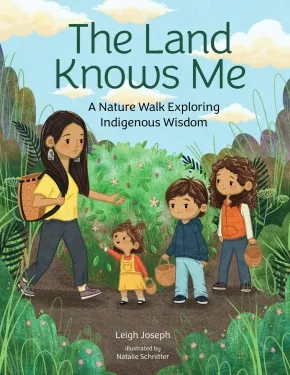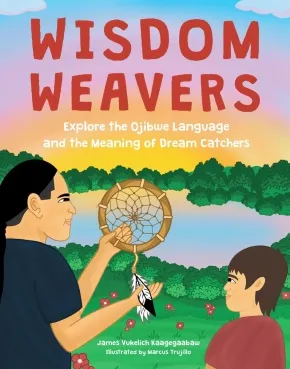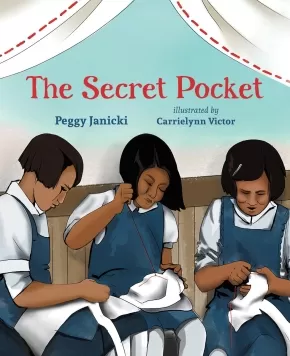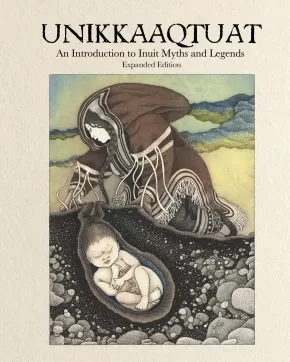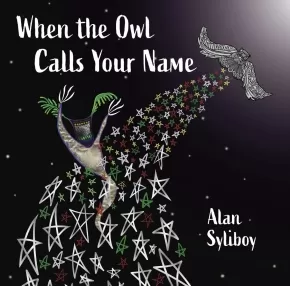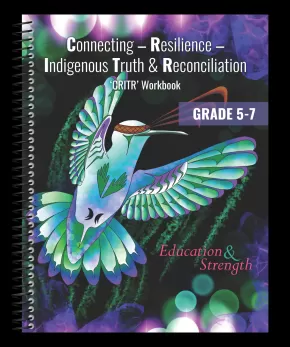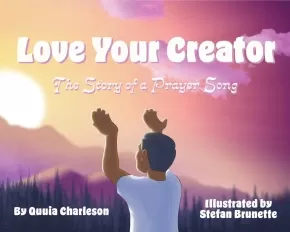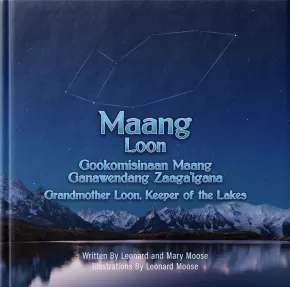
Indigenous Narratives
16
-
30
of
96 Results;
Sort By
Go To
of 7
The Land Knows Me: A Nature Walk Exploring Indigenous Wisdom
$25.99
Artists:
Format:
Hardcover
Text Content Territories:
Indigenous Canadian; First Nations; Salish; Coast Salish; Squamish;
ISBN / Barcode: 9780760392911
Synopsis:
Synopsis:
Through the Squamish language and cultural traditions, learn about Indigenous plant relationships and how we are all connected to nature through plant-based foods, medicines, and materials.
The best way to learn about plants is through observing and interacting with living examples. Join Held by the Land author Leigh Joseph and her children in The Land Knows Me, an educational, hands-on journey to discover all the wonderful uses and gifts of the plants around us. Through the Indigenous traditions of Squamish culture you’ll learn how to ground yourself on the land, how to introduce yourself in the Squamish language to your plant relatives, and the many teachings about plants, cultural stories, and learnings related to the flora seen on your walk.
This essential and colorful introduction to Indigenous plant knowledge includes informative sidebars, reflection questions, and plant names in both Squamish and English so children can learn a new language.
The Land Knows Me concludes with a 15 plant profile directory featuring detailed plant illustrations and kid-friendly botanical drawings to aid in learning about the many great uses for plants and the native history behind them. You’ll meet plants like:
- Ḵwiĺayus (kw-ill-eye-os), Red-Flowering Currant, Ribes sanguineum
- Ḵ’emeláý (k-em-ill-eye), Bigleaf Maple, Acer macrophyllum
- Séliýaý (s-elle-ee-eye), Oregon Grape, Mahonia nervosa
- Xápaýay (hey-pie-eye), Western Red Cedar, Thuja plicata
- Ḵwe7úpaý (kw-oh-pa-eye), Pacific Crabapple, Malus fusca
- And more!
The directory also includes important safety and proper harvesting information for parents who are looking for more opportunities to educate and engage with kids while getting to know the secrets of the land around us. Including mindfulness activities, how-to crafts, and yummy treats, The Land Knows Me calls you back again and again to learn something new with each engaging read!
Follow the stream, cross the field, and step into a forest full of rich, botanical diversity rooted in history and tradition.
Educator Information
Recommended for ages 6 to 8.
Additional Information
80 pages | 8.50" x 11.00" | Hardcover
The Seventh Direction Teacher Lesson Plan
$7.99
Artists:
Text Content Territories:
Indigenous American; Native American; Sioux; Lakota; Indigenous Canadian; First Nations; Sioux; Lakota;
ISBN / Barcode: 9781778540325
Synopsis:
Synopsis:
A teacher lesson plan that accompanies the book, The Seventh Direction. Includes comprehension questions, group activities, colouring pages, and more. In this enlightening legend shared by Lakota Elder Kevin Locke, Wakhan Thanka (The Great Spirit) created the entire world in seven days; leaving the most precious creation for last. In order to protect this precious creation, Wakhan Thanka needed to hide it where it would always be safe and turned to our animal relatives for help. Together, they found the perfect place. Do you know where they chose?
Educator Information
This lesson plan accompanies the book The Seventh Direction: A Legend of Creation.
This lesson plan is available in French: La septième direction Plan de cours
Additional Information
12 pages | 8.75" x 11.00" | Paper Packet
The Seventh Direction: A Legend of Creation
$20.99
Artists:
Format:
Hardcover
Text Content Territories:
Indigenous American; Native American; Sioux; Lakota; Indigenous Canadian; First Nations; Sioux; Lakota;
ISBN / Barcode: 9781778540134
Synopsis:
Synopsis:
In this enlightening legend shared by Lakota Elder Kevin Locke, Wakhan Thanka (The Great Spirit) created the entire world in seven days; leaving the most precious creation for last. In order to protect this precious creation, Wakhan Thanka needed to hide it where it would always be safe and turned to our animal relatives for help. Together, they found the perfect place. Do you know where they chose?
Awards
- Gold IPPA Book Award Winner (First Nations/Indigenous Communities category)
Reviews
"Fully immersive and thought-provoking, Locke's sage picture book will appeal to visionary younger readers who can grasp the teaching that humans must rediscover their link to the natural world, to "be a good relative, not just to the two-leggeds, but to all of creation" - a timely message." - Publishers Weekly
"...full of vivid color and imagery. A stirring tale of creation that will capture readers' attention. A good purchase for picture book collections." - School Library Journal Reviews (March 2024)
Educator Information
Recommended for ages 6 to 8.
A teacher lesson plan is available for this book: The Seventh Direction Teacher Lesson Plan.
This book is available in French: La septième direction: une légende de la création
Additional Information
44 pages | 8.76" x 11.03" | Hardcover
Wisdom Weavers: Explore the Ojibwe Language and the Meaning of Dream Catchers
$25.99
Artists:
Format:
Hardcover
Text Content Territories:
Indigenous American; Native American; Anishinaabeg; Ojibwe (Chippewa);
ISBN / Barcode: 9780760387191
Synopsis:
Synopsis:
Follow a day in the life of a young, mixed heritage Ojibwe child and learn key words and phrases from the Ojibwe language in this enchantingly illustrated children’s book.
The Ojibwe people are the largest Indigenous group of Turtle Island, now known as North America, and live around the present-day Great Lakes. After their land was taken by Europeans, many Ojibwe children were placed in boarding schools that forbid them to use their native language. Though this led to a decline in fluent speakers, there is a growing movement to restore the strength of the Ojibwe language.
In Ojibwe culture, a dream catcher (izhi’on) protects people, especially children, from harm by catching bad dreams in its web and allowing good dreams to pass through the feathers hanging at the bottom.
Wisdom Weavers introduces children to the Ojibwe language from an Indigenous perspective. International speaker, author, and creator of Ojibwe Word of the Day, James Vukelich Kaagegaabaw, presents a selection of words and phrases throughout the day while his son learns about the Ojibwe tradition of the dream catcher. Created with children ages 6 to 11 (beginner- to mid-level readers) in mind, Wisdom Weavers is an engaging and accessible way for children to discover the Ojibwe language and learn key phrases and words like:
How to welcome the morning - Mino-giizhigad
How to say I love you - Gizhawenimin
How to be grateful - Miigwech
How to make an offering - Biindaakoojige
School - Gikinoo’amaadiiwigamig
Tree - Mitig
Backpack -Bimiwanaan
Sun - Giizis
And more!
This inspiring story features a total of 73 words and phrases to learn in Ojibwe, introduced throughout the visually captivating and representative scenes showing an average day in an Ojibwe family from illustrator Marcus Trujillo, a tribal member with the Pueblo of Laguna in affiliation with the Village of Paraje. Also featuring a brief history of the Ojibwe people and language and a culturally accurate how-to guide for making a dream catcher at home, Wisdom Weavers immerses young people in a vibrant traditional culture while helping to keep the Ojibwe language and customs alive.
Educator Information
Recommended for ages 6 to 11.
This book includes some words and phrases in Ojibwe, but it is not a fully dual-language book.
Additional Information
32 pages | 8.50" x 11.00" | Hardcover
Arctic Song: Creation Stories From the Arctic
$28.95
Artists:
Format:
Hardcover
Text Content Territories:
Indigenous Canadian; Inuit;
Reading Level: N/A
ISBN / Barcode: 9781772274974
Synopsis:
Synopsis:
This poetic journey through Inuit oral history gives a glimpse of traditional beliefs surrounding the creation of the world. From the creation of day and night and the Sun and the Moon, to the origin of Death, this collection of simple retellings is richly supported by the artwork of acclaimed artist Germaine Arnattaujuq.
Featuring a foreword by the artist about her work illustrating Inuit myths and legends, this introduction to traditional Inuit stories is based on the animated film Arctic Song, which was co-produced and co-directed by Germaine Arnattaujuq and Neil Christopher.
Educator Information
Dual-language: English and Inuktitut
Additional Information
72 pages | 9.00" x 10.00" | Hardcover
Haywaas' Question: What Is Reconciliation?
$16.95
Format:
Paperback
Text Content Territories:
Indigenous Canadian; First Nations; Haida;
ISBN / Barcode: 9781738736706
Synopsis:
Synopsis:
After Haywaas sees his parents get frustrated while watching the news, this precocious 12-year-old begins a months-long journey navigating many different answers to what he thought was a simple question.
Expertly crafted by a teacher-parent-author duo, Haywaas’ Question is relatable, understandable, and aptly builds up to an answer we’re all a part of.
Educator Information
The publisher recommends this picture book for Grades 4 - 10.
This book is available in French: La Question de Haywaas: Qu'est-ce que la réconciliation?
Additional Information
36 pages | 7.00" x 9.00" | Paperback
Nutshimit: In the Woods
$22.99
Artists:
Format:
Hardcover
Text Content Territories:
Indigenous Canadian; First Nations; Innu (Montagnais-Naskapi); Ekuanitshit; Inuit; Métis;
ISBN / Barcode: 9781039701809
Synopsis:
Synopsis:
In this immersive first-person account, Innu author Melissa Mollen Dupuis teams up with award-winning author and illustrator Elise Gravel to take readers on a journey through Innu culture, from creation legends to life today.
The Innu word Nutshimit signifies the physical and social space to practice traditional activities and language. Join author Melissa Mollen Dupuis on a guided walk deep through the forest to learn some of the rich culture of the Innu people.
Readers will discover the importance of natural world and learn a few Innu words along the way. Thoughtfully brought to life by Elise Gravel’s signature comic style illustrations, Melissa’s colloquial narrative and anecdotes detailing her lived experiences offer a deeply personal look at Innu life.
Educator Information
Recommended for ages 6 to 8.
Children learn Innu nature vocabulary through anecdotes from author’s lived experiences.
Populated with Elise Gravel’s hilarious characters and plenty of fun details.
This book is available in French: Nutshimit: Un bain de forêt
Find an activity book for this title here: Nutshimit: Activity Book
Additional Information
88 pages | 8.00" x 11.00" | Hardcover
The Origin of Day and Night (PB)
$13.95
Artists:
Format:
Paperback
Text Content Territories:
Indigenous Canadian; Inuit;
ISBN / Barcode: 9781772274691
Synopsis:
Synopsis:
In very early times, there was no night or day and words spoken by chance could become real. When a hare and a fox meet and express their longing for light and darkness, their words are too powerful to be denied. Passed orally from storyteller to storyteller for hundreds of years, this beautifully illustrated story weaves together elements of an origin story and a traditional animal tale, giving young readers a window into Inuit mythology.
Educator Information
Recommended in a Canadian Indigenous Books for Schools resource list as being useful for grades 2-5 in these subject areas: English Language Arts, Social Studies.
Useful as a read-aloud, independent read, or information resource for students.
Additional Information
32 pages | 9.00" x 8.00" | Paperback
The Secret Pocket
$21.95
Artists:
Format:
Hardcover
Text Content Territories:
Indigenous Canadian; First Nations; Dene; Dakelh (Carrier);
ISBN / Barcode: 9781459833722
Synopsis:
Synopsis:
The true story of how Indigenous girls at a Canadian residential school sewed secret pockets into their dresses to hide food and survive
Mary was four years old when she was first taken away to the Lejac Indian Residential School. It was far away from her home and family. Always hungry and cold, there was little comfort for young Mary. Speaking Dakelh was forbidden and the nuns and priest were always watching, ready to punish. Mary and the other girls had a genius idea: drawing on the knowledge from their mothers, aunts and grandmothers who were all master sewers, the girls would sew hidden pockets in their clothes to hide food. They secretly gathered materials and sewed at nighttime, then used their pockets to hide apples, carrots and pieces of bread to share with the younger girls.
Based on the author's mother's experience at residential school, The Secret Pocket is a story of survival and resilience in the face of genocide and cruelty. But it's also a celebration of quiet resistance to the injustice of residential schools and how the sewing skills passed down through generations of Indigenous women gave these girls a future, stitch by stitch.
Awards
- 2023 Sunshine Coast Writers and Editors Society (SCWES) Book Awards for BC Authors joint winner
- 2024 Forest of Reading Silver Birch Express Award
Reviews
“In bringing her mother’s story to the world, Peggy Janicki has ignited a powerful fire for intergenerational healing. A vivid illustration of how Traditional Knowledge helped the children at residential schools be heroes for themselves and each other. Not only has Janicki meticulously documented everyday life as experienced by the students of the Lejac residential school but she has also highlighted their ingenious and courageous efforts to survive. Strengths-based, age-appropriate and vividly engaging.”— Christy Jordan-Fenton, award-winning author of Fatty Legs
“Beautifully illustrated and powerfully narrated, The Secret Pocket amplifies the voices and experiences of Indian Residential School Survivors. In doing so, Peggy Janicki and Carrielynn Victor make an important contribution to the work of putting truth before reconciliation.”— Sean Carleton, historian and author of Lessons in Legitimacy: Colonialism, Capitalism, and the Rise of State Schooling in British Columbia
“In this important story of courage and resistance, educator Peggy Janicki shares the story of her mother and other Survivors who sewed secret pockets into their dresses to hide food to feed themselves and others at Lejac residential school. We need to continue to hear these stories and share them with our children so we can move forward in our collective healing.”— Dr. Sara Florence Davidson, co-author of Potlach as Pedagogy: Learning Through Ceremony
“It is through stories that knowledge, understanding, empathy and the tools for deep and lasting change are passed on. Peggy Janicki has carried her mother’s story for us to hold in our hearts. This truth-telling and history-sharing will touch readers of all ages as they allow themselves to feel the weight of this powerful book.”— Amber Price, MGC, owner of The Book Man
Educator Information
Recommended for ages 6 to 8.
This book is available in French: La poche secrète.
Additional Information
32 pages | 8.75" x 10.75" | Hardcover
Unikkaaqtuat: An Introduction to Inuit Myths and Legends - Expanded Edition
$36.95
Artists:
Format:
Hardcover
Text Content Territories:
Indigenous Canadian; Inuit;
Grade Levels: 12; University/College;
ISBN / Barcode: 9781772274882
Synopsis:
Synopsis:
Unikkaaqtuat is the Inuktitut word meaning "to tell stories."
This definitive collection of Inuit legends is thoughtfully introduced and carefully annotated to provide the historical and cultural context in which to understand this rich oral tradition. Fascinating and educational, this little-known part of Canada's heritage will captivate readers of all ages. As a work of historical and cultural preservation, this textbook will be invaluable to those studying Inuit.
Additional Information
320 pages | 8.00" x 10.00" | 100 b&w line drawings | Hardcover | 2nd Edition
When the Owl Calls Your Name
$22.95
Artists:
Format:
Hardcover
Text Content Territories:
Indigenous Canadian; First Nations; Mi'kmaq;
ISBN / Barcode: 9781774712467
Synopsis:
Synopsis:
"The Owl Song" by Alan Syliboy & the Thundermakers is now a gorgeously illustrated book for all ages, exploring Mi'kmaw spirituality, life and death.
They say when the Owl calls your name
that the Creator is calling you home.
And when the owl comes to you,
he sits and waits until your final breath.
Then your journey begins.
From bestselling author Alan Syliboy (Mi'kmaw Daily Drum, Wolverine and Little Thunder, The Thundermaker) comes a beautiful new book exploring spirituality, mortality and grieving. An illustrated extended version of his popular song "The Owl Song," it features imagery inspired by his band Alan Syliboy & The Thundermakers' performance material and an author's note on Mi'kmaw tradition and Syliboy's own personal experiences with death. This book for all ages is a poignant depiction of what might happen when the Owl calls your name, and you begin your journey home to the ancestors.
Educator Information
The publisher recommends this picture book for all ages.
Subjects: death, grief, afterlife, spiritual, Mi'kmaw tradition
Additional Information
32 pages | 8.00" x 8.00" | Hardcover
Connecting – Resilience – Indigenous Truth & Reconciliation ‘CRITR’ Workbook: Grade 5 - 7
$29.95
Artists:
Format:
Coil Bound
Text Content Territories:
Indigenous Canadian; First Nations; Inuit; Métis;
ISBN / Barcode: 9781990448348
Synopsis:
Synopsis:
CRITR provides dozens of lessons and 100s of questions covering important topics including: Indigenous Canadian History, Residential Schools, Indigenous Contributions past and present, Treaties, and Indigenous Days of Recognition in Canada.
This book is a collection of parts of the history of the Indigenous Peoples in Canada and of the process of reconciliation. It is designed to educate all children and youth -- our future leaders -- about Indigenous history and current events. It is intended to give a better understanding and to positively contribute to reconciliation.
Together, we must consider the past, the present, and the future in our efforts to better ourselves and future generations.
This book provides a wealth of high-quality articles and learning activities, consisting of units and lessons that can be used by anyone -- teachers, parents, students, business professionals -- who may have little or no prior knowledge or understanding of Indigenous Peoples or subjects.
In this book, you will meet real Indigenous Peoples speaking out and sharing their stories and their firsthand experiences, and you will clearly hear their passion for reconciliation.
This book is unique. The stories told within its covers are unique, just like everyone working through their own journey of understanding and doing their small part towards reconciliation.
“We need to pursue reconciliation consistently and passionately. Education has gotten us into this mess, and education will get us out. We see this as our challenge and our hope.” -The Honourable Senator Murray Sinclair
Educator Information
Recommended for grades 5 to 7.
CRITR Workbook Features
- Indigenous knowledge from different Indigenous Peoples and Indigenous perspectives.
- Dozens of lessons covering important topics including Residential Schools, Treaties, and Indigenous Contributions.
- Beautiful original art on the cover and throughout the book.
- An Indigenous worldview expressing people's need to develop themselves and their children, in a way that addresses their spiritual, physical, emotional, and mental gifts.
- An approach to the teaching and healing process that is interconnected and cyclical in nature.
- An introduction to readers of the concept of a "sacred circle," also known as a medicine wheel, as well as First Peoples' principles of learning in general terms.
- Words of encouragement.
- A balance between too much and too little content.
- Information and a layout to inform and inspire without overwhelming the teacher or the student, in the classroom or at home.
- Fresh insights and learning activities for key Indigenous events that are celebrated annually in schools and communities across the Nation.
- Critical thinking questions to inspire new learning.
- Activities for individuals and groups.
- The font in the grade 5 to 7 book is ideal for young readers ( Arial 13.5-point font). Additionally, the grade 5 to 7 book features shorter sentence structure for easy reading and comprehension.
- A few activities and lessons featured in the grade 8 to 12 resource have been changed or removed in the grade 5 to 7 book due to the maturity level of the subject matter.
- Grade-level appropriate word choices to help with improved vocabulary.
How is the CRITR workbook organized?
Each lesson follows this pattern:
- An easy-to-read lesson that may be read in under 5 minutes
- A vocabulary focus called Word Power that defines key words from the lesson
- A set of questions easily answered from the reading
- A Critical Thinking section is included to enhance learning
- Sprinkled throughout the CRITR Workbook are relevant individual and group activity recommendations.
Additional resources are identified throughout the pages with links, including information about how to connect with the Indigenous authors and artists.
Activities, colouring, and word search pages may be downloaded for free. An answer key is included at the end of the book.
What will students learn from this resource?
- Reconciliation is about change, justice, respect, and re-building the relationships between the Indigenous and non-Indigenous Peoples in Canada
- Indigenous History of Canada
- Empathy that comes from understanding and being educated
- Knowledge about important and sensitive topics, including stories told by Indigenous authors about what occurred at residential schools. It is important to know these stories of assimilation
- Capacity for intercultural understanding, empathy, and mutual respect as prescribed specifically in CTA #63
Educator Information
For grades 5 to 7.
A $5 per book discount is applied to a purchase of 10 or more books.
This book is available in French: Connexion - Résilience - Vérité et réconciliation autochtones Ressource - 5e à 7e année
Additional Information
176 Pages | 9" x 11.5" x 0.5" | Spiral Bound
I Wish You Were Here
 $16.95
$16.95

Format:
Hardcover
Text Content Territories:
Indigenous Canadian; First Nations; Tsimshian (Ts'msysen); Haida;
ISBN / Barcode: 9781771745727
Synopsis:
Synopsis:
Dear Jean,
I had a substitute teacher recently. He stood up for a girl wearing a cedar hat when she was told to take it off by the vice-principal…
Even though Jean and Michael come from different cultural backgrounds and live far apart, they are best friends. To keep in touch, they write letters. Read their letters to discover what Jean and Michael do when they see and experience racial prejudice in their communities.
I Wish You Were Here is based on the authors' childhood experiences as pen pals in Haida Gwaii and Terrace in northern British Columbia. The book explores themes of friendship, culture, family, and community. It also addresses some tough issues, such as racism and intolerance, and explores ways to respond proactively. Included are resources and discussion questions to encourage further learning and reflection.
Reviews
“This lovely book explores healthy strategies for addressing racism and discrimination, including ceremonies, art, and intercultural allies. It is necessary reading for fostering the reconciliation and Indigenous resurgence that is imperative for our collective growth and enlightenment.” – Terri-Lynn Williams-Davidson, musician, author, activist, artist, and lawyer
“This book helps us to empower our children and each other in the important work of recognizing, talking about, and working through acts of racism.” – Severn Cullis-Suzuki, lifelong activist for intergenerational justice
Educator Information
Recommended for grades 3 to 7.
This middle-grade picture book includes discussion questions, a glossary, and additional resources for further learning and reflection.
Curriculum Connections & Keywords: Reconciliation, Indigenous Education, Social Awareness and Responsibility, Social Studies, Allyship, Racism, Anti-Racism, Discrimination, Social Justice, Racial Injustice, Haida, Haida Gwaii, Gwaii Haanas National Park, Tsimshian, Terrace, Letter Writing, Pen Pals, Friendship, Diversity, Child Empowerment, Advocacy, Inclusivity.
This book provides readers the opportunity to look at racism and discrimination through two different cultural lenses. It's a teaching tool to initiate conversations about issues such as racism, discrimination, and reconciliation.
In the video below, Erica Jean Reid Gidin Jaad shares how to pronounce Haida and Tsimshian words in I Wish You Were Here.
Additional Information
32 Pages | 6.5" x 9.5" | Hardcover | ISBN: 9781771745727
Love Your Creator: The Story of a Prayer Song
$20.95
Artists:
Format:
Paperback
Text Content Territories:
Indigenous Canadian; First Nations; Nuu-chah-nulth (Nootka); Hesquiaht;
ISBN / Barcode: 9781777894726
Synopsis:
Synopsis:
This is the true story behind a song that was once a hymn remembered from residential school. With the help of his family and community, especially the determination of his son, and encouraging words of his Grandmother, Knowledge Keeper Quuia Charleson (Nuu-Chah-Nulth), has reclaimed Love Your Creator and continues to share both the song and its story through oral tradition at events and on travels. Engaging illustrations by Stefan Brunette passionately portray the people and events in this exciting picture book for all ages. Discover the story and learn the strength of a song.
Educator Information
Recommended for ages 5 to 12.
This book is available in French: Aime ton Créateur: L'histoire d'une chanson de prière.
Additional Information
36 pages | 10.00" x 8.00" | Paperback
Maang/Loon: Gookomisinaan Maang Genawendang Zaaga'iganan (Grandmother Loon, Keeper of the Lakes)
$22.99
Artists:
Format:
Paperback
Text Content Territories:
Indigenous Canadian; First Nations; Anishinaabeg;
ISBN / Barcode: 9781990297311
Synopsis:
Synopsis:
Leonard Moose and Mary Moose tell us our Aadizookaanan or Sacred Stories were passed down for thousands of years, filling the long winter nights with Anishinaabeg Oral Histories, Philosophies, and Ceremonies. Maang, or the Loon, is one of these ancient stories that our Anishinaabeg Ancestors have gifted us.
There are many stories of the Loon. In this Aadizookaan, we will learn about Maang and the story of how Maang came to look the way this magnificent bird does today. The story of Maang is about how, through good deeds, we are rewarded. Maang is recognized by the good deeds with a necklace around Maang's neck and stars on Maang’s back. These markings on Maang are for all to see from generation to generation. “Maang” means “Grandmother, Keeper of the Lake”. We will also learn why Maang has a special place in the night sky as Giiwedinang, (North Star).
Educator Information
The publisher of this work recommends it for all grade levels.
In Anishinabemowin and English. Includes glossary.
Additional Information
48 Pages | Paperback
Sort By
Go To
of 7

